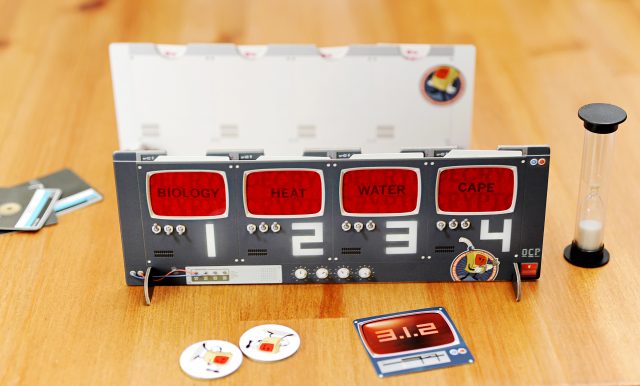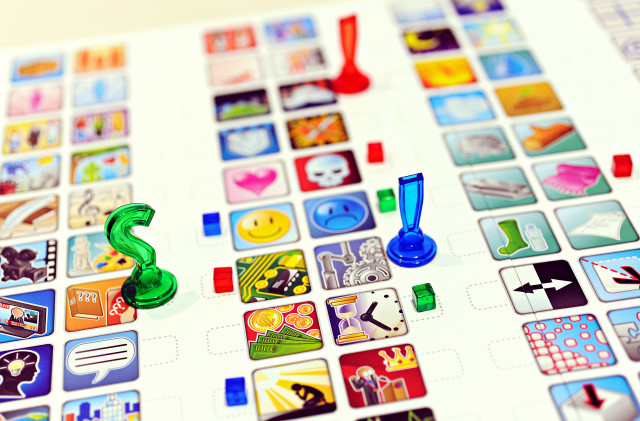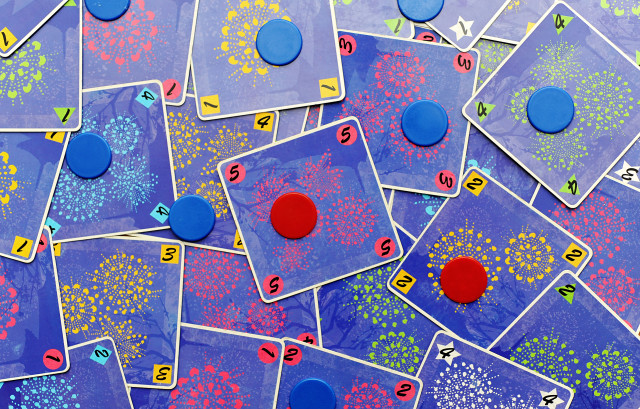How we share information back and forth is both intricate and nuanced. So, much of what we say is non-verbal that we for granted how important that verbal can be. Communication can occur between two people that don’t speak the same language, and often that will lead to new ways to share ideas.
The new game Decrypto is one of a growing list of what I’m calling communication games. They are often cooperative or team-based, because players are working to convey a message or thought against the confines of the game.
 In Decrypto, team of two or more will work together to crack a number of codes, while trying to figure out the secret words of their opponents.
In Decrypto, team of two or more will work together to crack a number of codes, while trying to figure out the secret words of their opponents.
Each team gets a screen, draws four Keyword cards, and places them in the four slots (numbered 1-4) of the screen. The Keyword cards hide their words until they are placed into the screen, when they will be magically revealed. The entire team will be able to see the words and the numbers associated with them.
Decrypto is played over eight or fewer rounds, with one team member taking the role of the Encryptor each round. They will draw a Code card containing a three-digit code, like 4-2-3 or 2-1-4. This is the code they need their team to identify through the clues they give.
The Encryptor writes down three one-word clues which should both lead their team to come up with the code, while obfuscating the Keywords for the other team. So, for example, if the keywords for a team are Doctor (1), Russia (2), Diver (3), Poem (4), and the Code card the Encryptor got was 3-2-4 they might give clues such as Ocean, Red, and Written. That should be enough for their teammates, who can see the words to identify the correct code. The other team will be able to record the clues and get a step closer to figuring out the hidden Keywords of their opponents.
 Both teams will secretly write down what they think the Code is. The non-active team goes first, revealing their guess of the Code. Early in the game it can be pretty tough, since they don’t have a lot of information to go on, but as the game progresses, they will have more and more clues with which to base their guesses on. The active team also reveals their guess of the Code based on the clues given.
Both teams will secretly write down what they think the Code is. The non-active team goes first, revealing their guess of the Code. Early in the game it can be pretty tough, since they don’t have a lot of information to go on, but as the game progresses, they will have more and more clues with which to base their guesses on. The active team also reveals their guess of the Code based on the clues given.
If the non-active team is successful in their attempt, they have intercepted the Code and receive an Interception token. If the active team is incorrect, they receive a Miscommunication token. It’s possible for both an Interception token and a Miscommunication token to be given out in the same round.
The trick for the Encryptor is to give clues that help their team without giving away the game to their opponents. As I mentioned above, early in the game it can be tough for a team to steal away the Code, but as it progresses they will gain a wealth of knowledge and have a better chance.
The game goes back and forth, with each team getting a chance to give a Code. The game ends immediately on a round with a team winning if they’ve collected two Interception tokens or losing if they have two Miscommunication tokens. With very little room for error, the stakes are high for every round.
The fun aspect of Decrypto is coming up with creative clues that will keep information from getting into the wrong hands. That is the case with many communication games. Here is a list of a few of my favourites:
 This is the king of communication games. Vlaada Chvital took a grid of 25 cards and gives the Codemasters fits as they try and get their team to identify their code words using one-word clues. They have to put up with their opponent’s words, neutral words, and the ever-dangerous Assassin card. Codenames won the Spiel des Jahres as the German game of the year and went on to create a bunch of sequels including Pictures, Duets, Disney, and more. With its simple gameplay, high replayability, and simple components, it is the gift that keeps on giving for CGE Games.
This is the king of communication games. Vlaada Chvital took a grid of 25 cards and gives the Codemasters fits as they try and get their team to identify their code words using one-word clues. They have to put up with their opponent’s words, neutral words, and the ever-dangerous Assassin card. Codenames won the Spiel des Jahres as the German game of the year and went on to create a bunch of sequels including Pictures, Duets, Disney, and more. With its simple gameplay, high replayability, and simple components, it is the gift that keeps on giving for CGE Games.
 One of the earlier communication games from a few years back also won the Spiel des Jahres. In Dixit players have to walk the tightrope between giving too much information and not enough. Players are dealt hands of beautiful tarot-sized illustrated cards. Each one feels like it was pulled from a children’s illustrated book. Each round someone takes a turn as the storyteller. They must say a word, or phrase, or just make a sound about one of the cards in their hand. Each other player puts one of their own cards in and they’re all shuffled together, then laid out face-up. Players vote on which card they think was the original. The key is to not be too obvious or vague. If everyone or no one finds the original, the storyteller gets no points.
One of the earlier communication games from a few years back also won the Spiel des Jahres. In Dixit players have to walk the tightrope between giving too much information and not enough. Players are dealt hands of beautiful tarot-sized illustrated cards. Each one feels like it was pulled from a children’s illustrated book. Each round someone takes a turn as the storyteller. They must say a word, or phrase, or just make a sound about one of the cards in their hand. Each other player puts one of their own cards in and they’re all shuffled together, then laid out face-up. Players vote on which card they think was the original. The key is to not be too obvious or vague. If everyone or no one finds the original, the storyteller gets no points.
 Concept is basically charades with pictures rather than actions. The board is made up of tons of different ideas to help you convey a thought, title, person, character or whatever to everyone else playing. By using the pawns and cubes, you tell them what the idea or concept (see what I did there?) is that you’ve picked off a card. So, for say, Santa Clause you might put the main idea pawn on fictional character (sorry kids), then tart a new idea with a pawn on the clothing picture and then add cubes on the red and white. Finally, you could start one more idea and indicate that they have something to do with a holiday. That should be enough for the players to guess Santa. That’s relatively easy, but wait til you try and explain more abstract ideas like Marxism or Empathy. Concept was also nominated for the Spiel des Jahres, ultimately losing to Camel Up, but I really thought it should have taken home the top prize that year.
Concept is basically charades with pictures rather than actions. The board is made up of tons of different ideas to help you convey a thought, title, person, character or whatever to everyone else playing. By using the pawns and cubes, you tell them what the idea or concept (see what I did there?) is that you’ve picked off a card. So, for say, Santa Clause you might put the main idea pawn on fictional character (sorry kids), then tart a new idea with a pawn on the clothing picture and then add cubes on the red and white. Finally, you could start one more idea and indicate that they have something to do with a holiday. That should be enough for the players to guess Santa. That’s relatively easy, but wait til you try and explain more abstract ideas like Marxism or Empathy. Concept was also nominated for the Spiel des Jahres, ultimately losing to Camel Up, but I really thought it should have taken home the top prize that year.
 I don’t have to go into too much detail for this game. If you know me, or have read the blog a lot, you know this is one of my favourite all-time games. I love Hanabi for both its simplicity in rules and challenge in execution. Players give clues to each other in an effort to play out cards in order. The trick is that they can’t see their cards themselves, just everyone else’s. There are five suits and you want to lay down five cards in order in each one. By carefully telling people information about the cards they have, hopefully your team will interpret the clues and play or discard the right cards. This game is high drama and oh so satisfying when everything works out. Not surprisingly, Hanabi was nominated and won the Spiel des Jahres.
I don’t have to go into too much detail for this game. If you know me, or have read the blog a lot, you know this is one of my favourite all-time games. I love Hanabi for both its simplicity in rules and challenge in execution. Players give clues to each other in an effort to play out cards in order. The trick is that they can’t see their cards themselves, just everyone else’s. There are five suits and you want to lay down five cards in order in each one. By carefully telling people information about the cards they have, hopefully your team will interpret the clues and play or discard the right cards. This game is high drama and oh so satisfying when everything works out. Not surprisingly, Hanabi was nominated and won the Spiel des Jahres.
You may have noticed that every game on the list was nominated or won the award for the top game of the year. Maybe it’s because, as people, we respond to the act of communication. None of these games are too complicated, but they all create an interaction between the players that is often lacking in everyday life, or even many games for that matter. Communication and interaction is one of the things that most humanizes us. Games like these make us do it in a creative way.
[…] times – and seeing large groups doing the same. You can read more about the game in Sean’s review, safe to say it was my fave party game of the […]